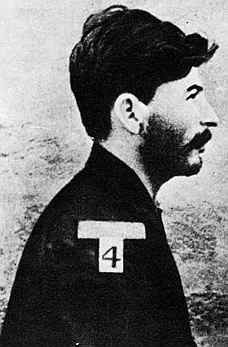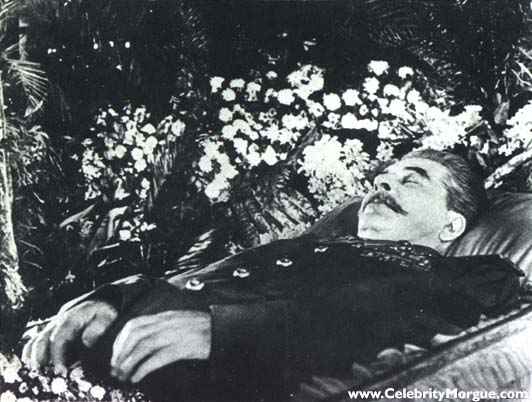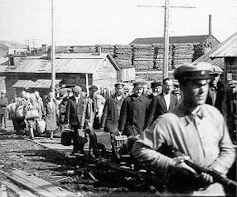|
Josef Stalin As a young man, Iosif Vissarionovich Djugashvili joined the Marxists in their bid to seize power and overthrow the Russian Tsar. He was exiled and imprisoned several times for his persistent revolutionary activities. After the police arrested him in 1902 for staging a prison raid, they made these notes in his record:
As a young man, Iosif Vissarionovich Djugashvili joined the Marxists in their bid to seize power and overthrow the Russian Tsar. He was exiled and imprisoned several times for his persistent revolutionary activities. After the police arrested him in 1902 for staging a prison raid, they made these notes in his record:
Height 2 archins, 4 1/2 vershoks. Body medium. Age 23. Special features: Second and third toes of the left foot attached. Appearance: Ordinary. Hair dark brown. Beard and moustaches: Brown. Nose straight and long. Forehead straight but low. Face long, swarthy and pockmarked. The swarthy, pockmarked perp with the deformed toes would later adopt a series of aliases to avoid future arrests. In 1913, the year after he was appointed to the party's Central Committee, Djugashvili finally settled on the humble name "Stalin," which means Man of Steel. In addition to his official duties, Mr. Steel immediately undertook the task of empire building. He capitalized on the vicious internecine warfare endemic to the Socialist movement, even going so far as to order the assassination of fellow revolutionaries whenever he thought it would help him consolidate power. Which was fairly often. The Bolshevists staged a coup in November 1917, following on the heels of the Russian revolution. Suddenly, Vladimir Lenin was in charge with Stalin as a member of his cabinet. The immediate result was yet another revolution. American troops landed on Russian soil in August 1918 to assist the anti-Bolshevik forces. They did not withdraw until 1920. By that time, it was all over; the Communists had won. At the Steelmeister's direction, the Kremlin launched a repressive campaign against Freemasonry in 1922, ultimately leading to the arrest and torture of avowed Masons. Masonic lodges were forced underground and did not emerge until the 1990s. Although Lenin was nominally in charge, his failing health soon left his ministers to fight over the resulting power vacuum. By 1928, Stalin's ascendance was complete. He had assumed the reins and most of his enemies were either dead or in exile. In 1929, Stalin expelled his chief rival and harshest critic, Leon Trotsky. Trotsky fled to Mexico City, where he wrote books and newspaper articles denouncing Stalin and his regime. In rebuttal, Stalin ordered his assassination. Trotsky was finally killed in 1940 after several unsuccessful attempts on his life. The assassin was the recipient of the Order of Lenin (Orden Lenina) upon his release from a Mexican prison. Then Stalin deliberately engineered a famine in the Ukraine. In 1932 he ordered all of the granaries emptied and their contents hauled off for export. In the spring of 1933, seven million people died of starvation in the nation's breadbasket. It was genocide on an immense scale. (Of course, this figure was later dwarfed by China's Great Leap Forward.)
When Stalin wasn't busy killing off large segments of his own population, he was dabbling in statecraft. In August 1939, he and Hitler inked a nonaggression pact. In retrospect, it seems that Hitler may not have been clear on the terms of their agreement. Buried way down in the fine print of Article I was some legal mumbo jumbo about the two countries not waging war on each other. In June 1941, Hitler launched a sneak attack on Russia. Three million German troops crossed the border at 3:15am. The incursion paralyzed Stalin. Subordinates handled the Nazi onslaught while he sat on his thumb, stupefied. There had been warnings. An agent in Tokyo reported in May that Hitler was preparing an imminent invasion of Russia. The information had been presented to Stalin, who chose to ignore it. For whatever reason, the man who had personally backstabbed countless friends and cohorts in his rise to power somehow believed that Hitler would never break their treaty. Go figure. One of Stalin's spymasters put it this way:
The generalissimo preferred to trust his political instinct rather than the secret reports piled up on his desk. Convinced that he had signed an eternal pact of friendship with Germany, he sucked on the pipe of peace. And he would have been sucking on more than just that pipe if only the Nazis had packed some cold-weather gear. As it happened, the Germans were counting on their blitzkreig strategy to effect sudden and decisive victory, leaving the Soviets no option but surrender. Consequently, they didn't bring their long underwear. Soon the Wehrmacht found themselves stuck in the Russian snow—just as Napoleon had, more than a century earlier. After Hitler's betrayal, Stalin was eager to join the capitalist nations fighting against Germany. For the remainder of the war, the USSR suspended their extreme loathing for the West and maintained an uneasy detente with the other Allies. This evaporated immediately after the Japanese surrender. The Russians were driven to develop an atomic bomb of their own. President Truman had made an offhard reference to the weapon during the Potsdam Conference in July 1945. During which time, Stalin feigned ignorance. As Truman recalled in his memoirs:
On July 24 I casually mentioned to Stalin that we had a new weapon of unusual destructive force. The Russian Premier showed no special interest. All he said was he was glad to hear it and hoped we would make "good use of it against the Japanese." Year later it was revealed that the Communists had actually been receiving periodic intelligence updates from Klaus Fuchs, a physicist working on the Manhattan Project. Stalin sent a telegram to Kurchatov after Potsdam, ordering him to rush their own atomic bomb program, which had been underway for years. The first Russian A-bomb was finally detonated in 1948. Stalin supported Mao's revolution in China, and put Kim Il Sung in charge of North Korea.

When the tyrant finally croaked from a cerebral hemorrhage in 1953—some have theorized that it may not have been from entirely natural causes—the country breathed a collective sigh of relief. A large number of gulag prisoners were granted amnesty and allowed to return home. Of the many thousands of citizens who waited hours in the snow to file past his body, it seems likely that nearly all of them just wanted to make certain he was truly dead.
|
 Which is right about the time that Stalin kicked the Gulag system into high gear. It was a constellation of forced labor camps, dispersed across the USSR. Criminals, dissidents, and anybody who pissed off the wrong person got shipped off to lay railroad tracks, dig canals, build dams, or extract ore from the mines. They toiled under inhuman conditions. Something like 50 million people died in the gulags; more than seven million between 1934 and 1938 alone.
Which is right about the time that Stalin kicked the Gulag system into high gear. It was a constellation of forced labor camps, dispersed across the USSR. Criminals, dissidents, and anybody who pissed off the wrong person got shipped off to lay railroad tracks, dig canals, build dams, or extract ore from the mines. They toiled under inhuman conditions. Something like 50 million people died in the gulags; more than seven million between 1934 and 1938 alone.